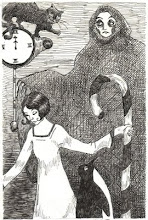
I really can't get excited enough about the renewed interest in representational art, and painting in particular. I have a real fondness for contemporary painters who use meticulous, classic techniques to create their work. My beloved Walton Ford, of course, springs immediately to mind, with his enormous and beautiful works on paper. But among the painters whose work I would go to great lengths to have hanging on my apartment walls, Mark Ryden's would be high on that list.
I love his strange cartoon-like world, perfectly realized using old master techniques. Big eyed, almost Margaret Keane looking children - often crying tears of blood, animals, strange symbols, trees, meat, Catholic iconography, celebrities and, often, Abraham Lincoln. It's a fascinating and modern stew.
He hails from the West Coast (Oregon) but has lived and worked in California all his adult life. He's not a native like Tim Burton or Francesca Lia Block, but he's still a part of this odd Los Angeles sensibility they all seem to share. He's one of a few modern painters (Elizabeth Peyton is one) who seem to understand the Celebrities don't matter, but Celebrity does. That these people on television and in magazines are as much a part of our national iconography (for good or ill) as Santa Claus or Jesus or the Hall of Presidents. These young artists are finishing the work that Warhol started. 
But Warhol missed the last twenty-five years. He really had no idea what was coming. Our culture seems to be collapsing in on itself, with Snookie speaking at universities and kids just wanting to be famous, rather than wanting to make something or do something or to be President. But, who am I to throw stones? I don't want to be president either. But I am eternally interested in artists who are really trying to make sense of it all. Mark Ryden and Mark Leyner. Cintra Wilson. Others. We are living in very strange and worrying times here in the post-Warhol, post-industrial present.

But Warhol missed the last twenty-five years. He really had no idea what was coming. Our culture seems to be collapsing in on itself, with Snookie speaking at universities and kids just wanting to be famous, rather than wanting to make something or do something or to be President. But, who am I to throw stones? I don't want to be president either. But I am eternally interested in artists who are really trying to make sense of it all. Mark Ryden and Mark Leyner. Cintra Wilson. Others. We are living in very strange and worrying times here in the post-Warhol, post-industrial present.
And we need art that will reflect it. It's such a weird thing. After seeing the Whitney exhibit in which they put Edward Hopper in the context of the times he lived in, one wonders what the same sort of exhibit would look like for contemporary artists a hundred years from now. The dawn of the twentieth century looks so optimistic in retrospect, and the dawn of the 21st so much less so.




















No comments:
Post a Comment